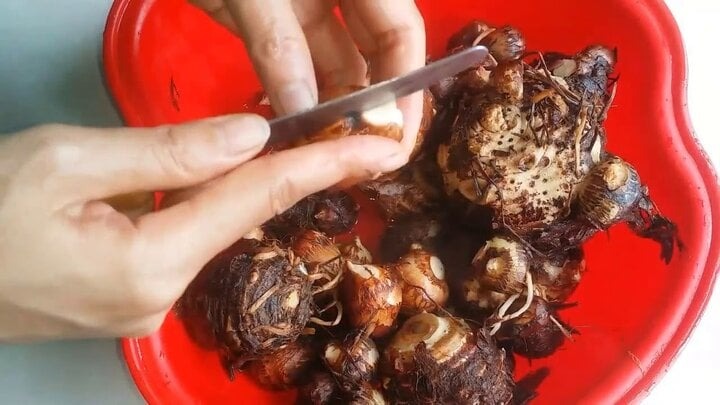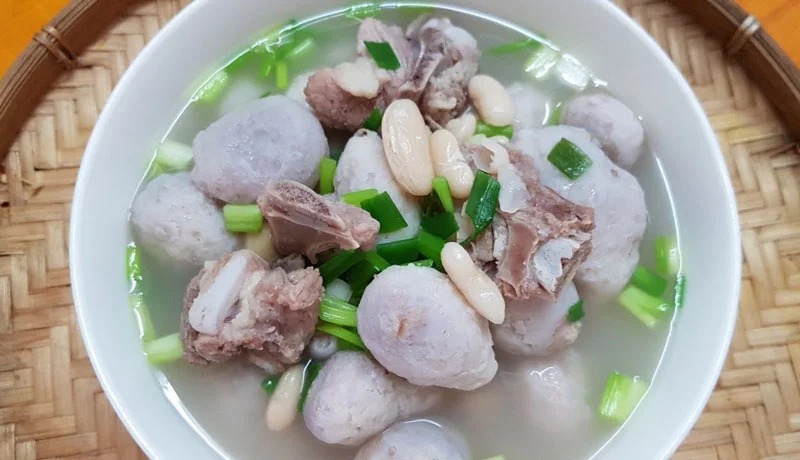Sweet potatoes are popular for their delicious flavor and high nutritional value. This type of potato not only aids digestion and prevents constipation but also provides essential vitamins and minerals to the body. However, as many people worry about itching when peeling sweet potatoes, they often avoid cooking with this type of potato.
## Tips to Avoid Itching When Peeling Sweet Potatoes:
Sweet potatoes contain calcium oxalate in the form of small crystals, which can cause irritation and itching when they come into contact with the skin. To avoid this when peeling sweet potatoes, you can apply the following tips:
1. **Keep your hands dry:** The simplest way is to keep your hands completely dry before peeling the potatoes. When buying sweet potatoes, you should not wash them right away but simply dry your hands before you start peeling.

The simplest way is to keep your hands dry before peeling potatoes.
2. **Wear gloves:** Wearing gloves is the most effective method to prevent itching. Gloves protect your skin from direct contact with oxalate crystals and keep your hands clean. You can use rubber gloves or disposable nylon gloves, whichever you prefer.
3. **Soak the potatoes in salted water:** Soaking sweet potatoes in salted water helps reduce itching by dissolving some of the oxalate crystals on the surface of the potatoes. Dissolve a little salt in water and soak the potatoes for about 15-20 minutes before peeling.
4. **Use vinegar or lemon:** Vinegar and lemon juice have acidic properties that help neutralize oxalate. Dilute vinegar or lemon juice with water and soak the sweet potatoes in this solution for about 10-15 minutes. This method reduces itching and keeps the potatoes white and beautiful after peeling.
5. **Parboil the potatoes before peeling:** Mix 2 teaspoons of salt into 1 liter of water, add the potatoes to the pot, and bring to a boil. When the water starts to boil, pour the potatoes into a colander and rinse them with cold water to cool them down before peeling. The water temperature helps break down the potatoes’ resin, reducing the risk of itching.
6. **Use cooking oil:** Before peeling, you can apply a thin layer of cooking oil on your hands to create a protective barrier. After peeling, wash your hands with soap to remove the oil and oxalate crystals.
## Tips to Deal with Itchy Hands After Peeling Sweet Potatoes:
If your hands itch after peeling sweet potatoes, you can try the following measures to alleviate the discomfort:
1. **Hold your hands over the fire:** The itch-causing substances in sweet potatoes are sensitive to heat. To reduce itching, you can hold your hands over a flame for about a minute, making sure to do so carefully to avoid burns. Gently and quickly wave your hands over the fire to reduce the itching sensation.

The itch-causing substances in sweet potatoes are sensitive to heat.
2. **Use vinegar or lemon:** To alleviate the itching, mix two tablespoons of vinegar or lemon juice with 2 liters of water and soak your hands in this solution for about 3-5 minutes. This will effectively reduce the itching sensation.
## Precautions When Using Sweet Potatoes:
To avoid any unwanted effects from sweet potatoes, keep the following in mind:
– Dispose of damaged or sprouted potatoes: To prevent food poisoning, do not consume potatoes that are damaged or have started to sprout.
– Peel the potatoes just enough: Avoid peeling too much of the skin to prevent the loss of protein found in the potato skin.
– Wear gloves when peeling: For those with sensitive skin, wearing gloves while peeling potatoes can reduce the risk of skin irritation.
– Soak and cook sweet potatoes thoroughly: Soaking and properly cooking sweet potatoes helps reduce the calcium oxalate content, thereby minimizing any side effects.
The Gem Tree: Beautifying Your Home and Attracting Wealth, a Must-Have for All
The Money Tree, otherwise known as the Jade Money Plant, is believed to bring good fortune and prosperity to its owners. With its vibrant green leaves and sturdy presence, this plant is said to attract positive energy and create a harmonious living space. Its ability to thrive and grow is a symbol of resilience and abundance, inspiring a sense of calm and well-being in those who care for it.
What’s the Best Way to Predict Someone’s Future?
In the art of physiognomy, the belief is that a person’s true nature can be revealed by observing specific facial features and characteristics. It is said that a quick glance at certain key points can offer a profound insight into an individual’s personality and destiny. This ancient practice has been passed down through generations, offering a fascinating glimpse into the potential depths of a person’s character.




































